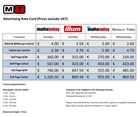
Technical specifications in Enemalta extension Reference is made to the comments made by Mr Evarist Bartolo on 18 April.The implication by Mr Bartolo that, in BWSC’s own words, the diesel engine plant offered is a bad deal, is completely misleading. The article refers to a presentation made by BWSC to Enemalta Corporation in 2005. At the time, BWSC were interested to supply a number of low speed diesel engines to meet Enemalta’s requirement for increase in generation plant. BWSC is fully owned by Mitsui Engineering and Shipbuilding Ltd. (MES). MES is a licensed builder of low speed diesel engines and it was to be expected that BWSC, at that stage, would recommend a solution manufactured by their parent company. However, when BWSC submitted their offer in response to the tender specification, it was for a plant with medium speed diesel engines as the prime movers. The reasons for this are most probably the tender requirement for flexible operation and to meet tight emissions limits. Inherently, low speed diesel engines exhibit higher specific NOx emission concentrations than medium speed units, making NOx emissions from these engines more problematic to remove. Moreover, in order for the Low Speed diesel units to be economically viable, their operating regime has to tend towards base load operation. The plant operating regime specified by Enemalta was a two shifting one. Therefore the plant offered had to be capable of a daily startup and shut down. With these two constraints, BWSC decided to submit plant powered by Medium Speed Diesel Engines. The report mentioned in the article refers to insurance claims received by one particular insurer (the Swedish club) for marine diesel engines and this cannot be taken as representative. Most sea going vessels which have short journey durations, such as cruise ships and small cargo vessels, tend to use medium speed diesel engines, whilst the very large tankers and container ships tend towards low speed engines. It is a known fact that the maintenance requirements of any plant operated on frequent start-stop cycles will be higher than for plant operated continuously. Whilst Mr Bartolo seems to want to denigrate an operating efficiency of 48%, this is actually considered to be high, particularly for a small flexible plant. Any comments? |
We asked.... Do you know what Vision 2015 is? 89% said ‘no’ Labour leads, but Gonzi makes slight recovery Survey confirms unpopularity of commuting Who’s the most trusted nanny in Gonzi’s cabinet? Consumers fishing around for better deals Robert Arrigo ‘most wanted’ for minister Cabinet thrives, but Fenech and Gatt hit rock bottom Bleak times – depression at the Grand Harbour Budget 2010 – Raise taxes or cut benefits? Only 35% will be taking a holiday this summer Corned beef? a matter of class Labour poised for absolute majority |
Managing editor Saviour Balzan | Tel. ++356 21382741 | Fax: ++356 21385075 | Email




